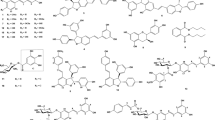Abstract
In the course of finding Korean natural products with acetylcholinesterase (AChE) inhibitory activity, we found that a methanolic extract of the twigs ofVaccinium oldhami significantly inhibited AChE. Bioassay-guided fractionation of the methanolic extract resulted in the isolation of two compounds, taraxerol (1) and scopoletin (2), as active constituents. These compounds inhibited AChE activity in a dose-dependent manner, and the IC50 values of compounds1 and2 were 33.6 (79 μM) and 10.0 (52 μM) μg/mL, respectively.
Similar content being viewed by others
References
Bartus, R. T., On neurodegenerative diseases, models, and treatment strategies: lessons learned and lessons forgotten a generation following the cholinergic hypothesis.Exp. Neurol., 163, 495–529 (2000).
Bartus, R. T., Dean, R. L., Beer, B., and Lippa, A. S., The cholinergic hypothesis of geriatric memory dysfunction.Science, 217, 408–414 (1982).
Broadwell, R. D. and Sofroniew, M. V., Serum proteins bypass the blood-brain fluid barriers for extracellular entry to the central nervous system.Exp. Neurol., 120, 245–263 (1993).
Chung, Y. K., Heo, H. J., Kim, E. K., Kim, H. K., Huh, T. L., Lim, Y., Kim, S. K., and Shin, D. H., Inhibitory effect of ursolic acid purified fromOriganum majorana L. on the acetylcholinesterse.Mol. Cells, 11, 137–143 (2001).
Ellman, G. L., Courtney, D., Valentino, A., and Featherstone, R. M., A new and rapid colorimetric determination of acetylcholinesterase activity.Biochem. Pharmacol., 7, 88–95 (1961).
Gunasekera, S. P., Cordell, G. A., and Farnsworth, N. R., Constituents ofNealchornea yapurenis (Euophorbiaceae).J. Nat. Prod., 43, 285–287 (1980).
Hwang, S. Y., Chang, Y. P., Byun, S. J., Jeon, M. H., and Kim, Y. C., An acetylcholinesterase inhibitor isolated from Corydalis Tuber and its mode of action.Kor. J. Pharmacogn., 27, 91–95 (1996).
Kalauni, S. K., Choudhary, M. I., Khalid, A., Manandhar, M. D., Shaheen, F., Atta-ur-Rahman, and Gewali, M. B., New cholinesterase inhibiting steroidal alkaloids from the leaves ofSarcococca coriacea of Nepalese origin.Chem. Pharm. Bull., 50, 1423–1426 (2002).
Kim, C. M. and Kang, S. S., Studies on the constituents of the stems ofEchinosophora koreensis.Yakhak Hoeji, 30, 139–142 (1986).
Kim, T. J.,Korean resources plants III. Seoul National Univ., Seoul, p 230, (1996).
Mortensen, S. R., Chanda, S. M., Hooper, M. J., and Padilla, S., Maturational differences in chlorpyrifos-oxonase activity may contribute to age-related sensitivity to chlorpyrifos.J. Biochem. Toxicol., 11, 279–287 (1996).
Ogihara, K., Higa, M., Hokama, K., and Suga, T., Triterpenes from the leaves ofParsonsia laevigata.Phytochemstry, 26, 783–785 (1987).
Park, C. H., Kim, S. H., Choi, W., Lee, Y. J., Kim, J. S., Kang, S. S., and Suh, Y. H., Novel anticholinesterase and antiamnesic activities of dehydroevodiamine, a constituent ofEvodia rutaecarpa.Planta Med., 62, 405–409 (1996).
Perry, E. K., The cholinergic hypothesis-ten years on.Br. Med. Bull., 42, 63–69 (1986).
Rhee, I. K., van de Meent, M., Ingkaninan, K., and Verpoorte, R., Screening for acetylcholinesterase inhibitors from Amaryllidaceae using silica gel thin-layer chromatography in combination with bioactivity staining.J. Chromatogr. A, 915, 217–223 (2001).
Riger, F., Shelanski, M. L., and Greene, L. A., The effects of nerve growh factor on acetylcholinesterase and its multiple forms in cultures of rat PC12 pheochromocytoma cells; increased total specific activity and appearance of the 16 S molecular form.Dev. Biol., 76, 238–243 (1980).
Sakurai, N., Yaguchi, Y., and Inoue, t., Triterpenoids fromMyrica rubra.Phytochemistry, 26, 217–219 (1987).
Song, J. T.,The sauras of Korean resources plants II. Il-heung, Seoul, pp 48–49, (1989).
Sugimoto, H., Ogura, H., Arai, Y., limura, Y., and Yamanishi, Y., Research and Developmetnt of donepezil hydrochloride, a new type of acetylcholinesterase inhibitor.Jpn. J. Pharmaco., 89, 7–20 (2002).
Author information
Authors and Affiliations
Corresponding author
Rights and permissions
About this article
Cite this article
Lee, J.H., Lee, K.T., Yang, J.H. et al. Acetylcholinesterase inhibitors from the twigs ofvaccinium oldhami miquel. Arch Pharm Res 27, 53–56 (2004). https://doi.org/10.1007/BF02980046
Received:
Issue Date:
DOI: https://doi.org/10.1007/BF02980046




